Theranostics Using MCM-41-Based Mesoporous Silica Nanoparticles: Integrating Magnetic Resonance Imaging and Novel Chemotherapy for Breast Cancer Treatment
Abstract
:1. Introduction
2. Results
2.1. MCM-41 Synthesis
2.2. Functionalization of MCM-41 with APTES (MCM-41-NH2)
2.3. Conjugation of MCM-41-NH2 with DTPA (MCM-41-NH2-DTPA) and Complexation of MCM-41-NH2-DTPA with Gd3+ (SiO2-NH2-DTPA-Gd3+)
2.4. Changes in Zeta Potential of Nanomaterials following Surface Modifications
2.5. Adsorption and Release of MIH 2.4Bl onto the MCM-41-NH2-DTPA-Gd3+ Nanomaterial
2.6. In Vitro Cytotoxicity Studies
2.7. Relaxometry and MRI Phantom Studies of MCM-41-NH2-DTPA-Gd3+-MIH
2.8. In Vivo Imaging
3. Discussion
4. Material and Methods
4.1. Materials and Reagents
4.2. Synthesis of Mesoporous Silica (MCM-41)
4.3. Functionalization of MCM-41 with APTES (MCM-41-NH2)
4.4. Conjugation of MCM-41-NH2 with Diethylenetriaminepentaacetic Dianhydride (DTPA)—(MCM-41-NH2-DTPA)
4.5. Complexation of MCM-41-NH2-DTPA with Gadolinium (Gd3+)—(MCM-41-NH2-DTPA-Gd3+)
4.6. Adsorption of MIH 2.4Bl Drug to MCM-41-NH2-DTPA-Gd3+Nanomaterial (MCM-41-NH2-DTPA-Gd3+-MIH)
- qt is the adsorption capacity, or the amount of drug adsorbed per unit mass of the adsorbent at time t, given in mg/g.
- C0 (mg/L) is the initial concentration of the adsorbate.
- Ct is the adsorbate concentration at time t, given in mg/L.
- m is the mass of the adsorbent, given in grams (g).
- V is the volume of the solution, given in liters (L).
4.7. Drug Release of the Mesoionic Drug MIH 2.4Bl Adsorbed to MCM-41-NH2-DTPA-Gd3+.
4.8. Material Characterizations
4.8.1. Fourier Transform Infrared Spectroscopy with Attenuated Total Reflectance (ATR-FTIR)
4.8.2. Scanning Electron Microscope (SEM)
4.9. Inductively Coupled Plasma Optical Emission Spectrometry (ICP-OES)
4.10. Porosimetry
4.11. Zeta Potential
4.12. Transmission Electron Microscopy (TEM)
4.13. MRI Phantom Studies
- Field of view (FOV): 75/37.5 cm, providing adequate sample coverage.
- Slice thickness: 1 mm to ensure optimal spatial resolution.
- Repetition time (TR): 1000 ms, adjusted to optimize contrast between different tissues.
- Echo time (TE): 11 ms, chosen to minimize signal loss due to magnetic field inhomogeneities.
- Number of slices: 12, allowing detailed visualization of the sample in multiple sections.
- Flip angle: 90° to maximize the received signal.
- Number of averages: 7, aiming to improve the signal-to-noise ratio.
- Slice gap: 0.2 mm to avoid overlap or gaps between slices.
- Total acquisition time: 14 min, balancing the need for high-quality imaging with time efficiency.
4.14. Relaxometry
4.15. Biological Characterizations
4.15.1. Cell Culture
4.15.2. Cell Viability Assay
4.15.3. Injection of 4T1 Cells in BALB/c Mice
4.15.4. MRI Analysis in BALB/c Mice with Tumors
- T1-weighted images (Tw1) were acquired before injection and 15 min after the intratumoral injection of the nanoparticles, with a field of view (FOV) of 100/50 cm, a slice thickness of 1 mm, a repetition time (TR) of 1000 ms, an echo time (TE) of 11 ms, 12 slices with a flip angle of 90°, 7 averages, and a slice gap of 0.2 mm.
- After the acquisition, the images were processed and visualized using 3D Slicer software and quantified using AMIDE software as described previously.
4.16. Statistical Analysis
Author Contributions
Funding
Institutional Review Board Statement
Data Availability Statement
Acknowledgments
Conflicts of Interest
References
- Xu, Y.; Gong, M.; Wang, Y.; Yang, Y.; Liu, S.; Zeng, Q. Global trends and forecasts of breast cancer incidence and deaths. Sci. Data 2023, 10, 334. [Google Scholar] [CrossRef] [PubMed]
- Coleman, C. Seminars in oncology nursing. In Early Detection and Screening for Breast Cancer; Elsevier: Amsterdam, The Netherlands, 2017; pp. 141–155. [Google Scholar]
- Arian, A.; Ghazanfari Hashemi, M.; Talebi, V.; AhmadiNejad, N.; Eslami, B.; Sedighi, N.; Omranipour, R. Abbreviated breast MRI for evaluating breast cancer before initiation of neoadjuvant chemotherapy: A cross-sectional study. Eur. J. Radiol. Open 2023, 11, 100517. [Google Scholar] [CrossRef] [PubMed]
- André, F.; Baselga, J.; Bergh, J.; Bonnefoi, H.; Brucker, S.; Cardoso, F.; Carey, L.; Ciruelos, E.; Cuzick, J.; Denkert, C. De-escalating and escalating treatments for early-stage breast cancer: The St. Gallen International Expert Consensus Conference on the Primary Therapy of Early Breast Cancer 2017. Ann. Oncol. 2017, 28, 1700–1712, Erratum in Ann. Oncol. 2018, 29, 2153. [Google Scholar]
- Ignatiadis, M.; Buyse, M.; Sotiriou, C. St Gallen International Expert Consensus on the primary therapy of early breast cancer: An invaluable tool for physicians and scientists. Ann. Oncol. 2015, 26, 1519–1520. [Google Scholar] [CrossRef] [PubMed]
- Morigi, C. Highlights from the 15th St Gallen International Breast Cancer Conference 15–18 March, 2017, Vienna: Tailored treatments for patients with early breast cancer. Ecancermedicalscience 2017, 11, 732. [Google Scholar] [CrossRef] [PubMed]
- Malhotra, G.K.; Zhao, X.; Band, H.; Band, V. Histological, molecular and functional subtypes of breast cancers. Cancer Biol. Ther. 2010, 10, 955–960. [Google Scholar] [CrossRef] [PubMed]
- Key, T.J.; Verkasalo, P.K.; Banks, E. Epidemiology of breast cancer. Lancet Oncol. 2001, 2, 133–140. [Google Scholar] [CrossRef] [PubMed]
- Chlebowski, R.T.; Hendrix, S.L.; Langer, R.D.; Stefanick, M.L.; Gass, M.; Lane, D.; Rodabough, R.J.; Gilligan, M.A.; Cyr, M.G.; Thomson, C.A.; et al. Influence of estrogen plus progestin on breast cancer and mammography in healthy postmenopausal women: The Women’s Health Initiative Randomized Trial. JAMA 2003, 289, 3243–3253. [Google Scholar] [CrossRef] [PubMed]
- Ellingjord-Dale, M.; Vos, L.; Vik Hjerkind, K.; Hjartåker, A.; Russnes, H.G.; Tretli, S.; Hofvind, S.; dos-Santos-Silva, I.; Ursin, G. Number of risky lifestyle behaviors and breast cancer risk. JNCI Cancer Spectr. 2018, 2, pky030. [Google Scholar] [CrossRef] [PubMed]
- Brody, J.G.; Rudel, R.A. Environmental pollutants and breast cancer. Environ. Health Perspect. 2003, 111, 1007–1019. [Google Scholar] [CrossRef] [PubMed]
- Baxter, G.C.; Selamoglu, A.; Mackay, J.W.; Bond, S.; Gray, E.; Gilbert, F.J. A meta-analysis comparing the diagnostic performance of abbreviated MRI and a full diagnostic protocol in breast cancer. Clin. Radiol. 2021, 76, 154.e23–154.e32. [Google Scholar] [CrossRef] [PubMed]
- Ramli Hamid, M.T.; Ab Mumin, N.; Abdul Hamid, S.; Ahmad Saman, M.S.; Rahmat, K. Abbreviated breast magnetic resonance imaging (MRI) or digital breast tomosynthesis for breast cancer detection in dense breasts? A retrospective preliminary study with comparable results. Clin. Radiol. 2024, 79, e524–e531. [Google Scholar] [CrossRef] [PubMed]
- Morrow, M.; Waters, J.; Morris, E. MRI for breast cancer screening, diagnosis, and treatment. Lancet 2011, 378, 1804–1811. [Google Scholar] [CrossRef] [PubMed]
- Gegios, A.R.; Peterson, M.S.; Fowler, A.M. Breast Cancer Screening and Diagnosis: Recent Advances in Imaging and Current Limitations. PET Clin. 2023, 18, 459–471. [Google Scholar] [CrossRef] [PubMed]
- Kadioglu, M.E.; Metin, Y.; Metin, N.O.; Tasci, F.; Ozdemir, O.; Kupeli, A. The efficacy of abbreviated breast MRI protocols using 1.5 T MRI in the preoperative staging of newly diagnosed breast cancers. Clin. Imaging 2023, 101, 44–49. [Google Scholar] [CrossRef] [PubMed]
- Jacob, G.; Jose, I.; Sujatha, S. Breast cancer detection: A comparative review on passive and active thermography. Infrared Phys. Technol. 2023, 134, 104932. [Google Scholar] [CrossRef]
- Yang, C.T.; Hattiholi, A.; Selvan, S.T.; Yan, S.X.; Fang, W.W.; Chandrasekharan, P.; Koteswaraiah, P.; Herold, C.J.; Gulyas, B.; Aw, S.E.; et al. Gadolinium-based bimodal probes to enhance T1-Weighted magnetic resonance/optical imaging. Acta Biomater. 2020, 110, 15–36. [Google Scholar] [CrossRef] [PubMed]
- Pediconi, F.; Catalano, C.; Roselli, A.; Padula, S.; Altomari, F.; Moriconi, E.; Pronio, A.M.; Kirchin, M.A.; Passariello, R. Contrast-enhanced MR mammography for evaluation of the contralateral breast in patients with diagnosed unilateral breast cancer or high-risk lesions. Radiology 2007, 243, 670–680. [Google Scholar] [CrossRef] [PubMed]
- Abotaleb, M.; Kubatka, P.; Caprnda, M.; Varghese, E.; Zolakova, B.; Zubor, P.; Opatrilova, R.; Kruzliak, P.; Stefanicka, P.; Busselberg, D. Chemotherapeutic agents for the treatment of metastatic breast cancer: An update. Biomed. Pharmacother. 2018, 101, 458–477. [Google Scholar] [CrossRef] [PubMed]
- Shen, L.; Zhou, P.; Wang, Y.M.; Zhu, Z.; Yuan, Q.; Cao, S.; Li, J. Supramolecular nanoparticles based on elastin-like peptides modified capsid protein as drug delivery platform with enhanced cancer chemotherapy efficacy. Int. J. Biol. Macromol. 2024, 256 Pt 2, 128107. [Google Scholar] [CrossRef] [PubMed]
- Deng, C.; Liu, Y.; Zhou, F.; Wu, M.; Zhang, Q.; Yi, D.; Yuan, W.; Wang, Y. Engineering of dendritic mesoporous silica nanoparticles for efficient delivery of water-insoluble paclitaxel in cancer therapy. J. Colloid Interface Sci. 2021, 593, 424–433. [Google Scholar] [CrossRef] [PubMed]
- Badami, B.V. Mesoionic compounds: An unconventional class of aromatic heterocycles. Resonance 2006, 11, 40–48. [Google Scholar] [CrossRef]
- Amaral de Mascena Costa, L.; Harmon, A.C.; Aguiar Coelho Teixeira, A.; Cassio Silva de Lima, F.; de Sousa Araujo, S.; Del Piero, F.; Diogenes da Silva Souza, H.; Filgueiras de Athayde Filho, P.; Alves Junior, S.; de Mascena Diniz Maia, M.; et al. Cytotoxic Activity of the Mesoionic Compound MIH 2.4Bl in Breast Cancer Cell Lines. Breast Cancer 2020, 14, 1178223420913330. [Google Scholar] [CrossRef] [PubMed]
- Wen, H.; Jung, H.; Li, X. Drug Delivery Approaches in Addressing Clinical Pharmacology-Related Issues: Opportunities and Challenges. AAPS J. 2015, 17, 1327–1340. [Google Scholar] [CrossRef] [PubMed]
- Lorscheider, M.; Gaudin, A.; Nakhle, J.; Veiman, K.L.; Richard, J.; Chassaing, C. Challenges and opportunities in the delivery of cancer therapeutics: Update on recent progress. Ther. Deliv. 2021, 12, 55–76. [Google Scholar] [CrossRef]
- de Mascena Costa, L.A.; Debnath, D.; Harmon, A.C.; de Sousa Araujo, S.; da Silva Souza, H.D.; de Athayde Filho, P.F.; Wischral, A.; Adriao Gomes Filho, M.; Mathis, J.M. Mechanistic studies of cytotoxic activity of the mesoionic compound MIH 2.4Bl in MCF-7 breast cancer cells. Oncol. Lett. 2020, 20, 2291–2301. [Google Scholar] [CrossRef] [PubMed]
- Vallet-Regí, M.; Schüth, F.; Lozano, D.; Colilla, M.; Manzano, M. Engineering mesoporous silica nanoparticles for drug delivery: Where are we after two decades? Chem. Soc. Rev. 2022, 51, 5365–5451. [Google Scholar] [CrossRef] [PubMed]
- Chow, J.C.L. Magnetic nanoparticles as contrast agents in magnetic resonance imaging and radiosensitizers in radiotherapy. In Fundamentals and Industrial Applications of Magnetic Nanoparticles; Elsevier: Amsterdam, The Netherlands, 2022; pp. 291–316. [Google Scholar]
- Vahabi, L.; Rashidi Ranjbar, P.; Davar, F. Cladosporium protease/doxorubicin decorated Fe3O4@SiO2 nanocomposite: An efficient nanoparticle for drug delivery and combating breast cancer. J. Drug Deliv. Sci. Technol. 2023, 80, 104144. [Google Scholar] [CrossRef]
- Ghazimoradi, M.; Tarlani, A.; Alemi, A.; Ghorbani, M.; Hamishehkar, H. Core-triple shells pH-responsive zinc-ferrite nanocomposite: Efficient dual remedy for targeted lung cancer therapy. J. Drug Deliv. Sci. Technol. 2023, 88, 104950. [Google Scholar] [CrossRef]
- Carvalho, R.F.S.; Pereira, G.A.L.; Rocha, J.; Castro, M.M.C.A.; Granadeiro, C.M.; Nogueira, H.I.S.; Peters, J.A.; Geraldes, C.F.G.C. Lanthanopolyoxometalate-Silica Core/Shell Nanoparticles as Potential MRI Contrast Agents. Eur. J. Inorg. Chem. 2021, 2021, 3458–3465. [Google Scholar] [CrossRef]
- Cheng, Y.J.; Zeng, X.; Cheng, D.B.; Xu, X.D.; Zhang, X.Z.; Zhuo, R.X.; He, F. Functional mesoporous silica nanoparticles (MSNs) for highly controllable drug release and synergistic therapy. Colloids Surf. B Biointerfaces 2016, 145, 217–225. [Google Scholar] [CrossRef] [PubMed]
- Yang, J.; Zhao, Q.; Zang, Z.; Zhang, S.; Wang, Z.; Li, L.; Yu, X.; Yang, X.; Lu, Z.; Zhang, X. A dual-mode T1 MRI/CT contrast agent of Gd2O3/Au@ MSNs for tumor imaging with high performance. Materialia 2022, 24, 101494. [Google Scholar] [CrossRef]
- Oh, J.Y.; An, E.-K.; Jana, B.; Kim, H.; Jin, S.; Yang, G.; Kim, J.; Choi, E.; Jin, J.-O.; Ryu, J.-H. Antibody plug-and-playable nanoparticles as a facile and versatile platform for targeted drug delivery. Chem. Eng. J. 2023, 470, 144357. [Google Scholar] [CrossRef]
- Zarkesh, K.; Heidari, R.; Iranpour, P.; Azarpira, N.; Ahmadi, F.; Mohammadi-Samani, S.; Farjadian, F. Theranostic Hyaluronan Coated EDTA Modified Magnetic Mesoporous Silica Nanoparticles for Targeted Delivery of Cisplatin. J. Drug Deliv. Sci. Technol. 2022, 77, 103903. [Google Scholar] [CrossRef]
- Estevao, B.M.; Vilela, R.R.; Geremias, I.P.; Zanoni, K.P.; de Camargo, A.S.; Zucolotto, V. Mesoporous silica nanoparticles incorporated with Ir (III) complexes: From photophysics to photodynamic therapy. Photodiagn. Photodyn. Ther. 2022, 40, 103052. [Google Scholar] [CrossRef] [PubMed]
- Liu, W.; Chen, B.; Zheng, H.; Xing, Y.; Chen, G.; Zhou, P.; Qian, L.; Min, Y. Advances of nanomedicine in radiotherapy. Pharmaceutics 2021, 13, 1757. [Google Scholar] [CrossRef] [PubMed]
- Viana, R.D.S.; Costa, L.A.D.M.; Harmon, A.C.; Gomes Filho, M.A.; Falcão, E.H.; Vicente, M.G.; Junior, S.A.; Mathis, J.M. 177Lu-Labeled Eu-doped mesoporous SiO2 nanoparticles as a theranostic radiopharmaceutical for colorectal cancer. ACS Appl. Nano Mater. 2020, 3, 8691–8701. [Google Scholar] [CrossRef]
- Siddique, S.; Chow, J.C. Recent advances in functionalized nanoparticles in cancer theranostics. Nanomaterials 2022, 12, 2826. [Google Scholar] [CrossRef] [PubMed]
- Niu, S.; Zhang, X.; Williams, G.R.; Wu, J.; Gao, F.; Fu, Z.; Chen, X.; Lu, S.; Zhu, L.M. Hollow Mesoporous Silica Nanoparticles Gated by Chitosan-Copper Sulfide Composites as Theranostic Agents for the Treatment of Breast Cancer. Acta Biomater. 2021, 126, 408–420. [Google Scholar] [CrossRef] [PubMed]
- Lin, F.-C.; Xie, Y.; Deng, T.; Zink, J.I. Magnetism, ultrasound, and light-stimulated mesoporous silica nanocarriers for theranostics and beyond. J. Am. Chem. Soc. 2021, 143, 6025–6036. [Google Scholar] [CrossRef] [PubMed]
- Molkenova, A.; Atabaev, T.S.; Hong, S.W.; Mao, C.; Han, D.-W.; Kim, K.S. Designing inorganic nanoparticles into computed tomography and magnetic resonance (CT/MR) imaging-guidable photomedicines. Mater. Today Nano 2022, 18, 100187. [Google Scholar] [CrossRef]
- Laprise-Pelletier, M.; Bouchoucha, M.; Lagueux, J.; Chevallier, P.; Lecomte, R.; Gossuin, Y.; Kleitz, F.; Fortin, M.-A. Metal chelate grafting at the surface of mesoporous silica nanoparticles (MSNs): Physico-chemical and biomedical imaging assessment. J. Mater. Chem. B 2015, 3, 748–758. [Google Scholar] [CrossRef] [PubMed]
- Bordoni, A.V.; Lombardo, M.V.; Wolosiuk, A. Rapid pore expansion of mesoporous silica-based materials using microwave irradiation and pore swelling agents. Mater. Chem. Phys. 2021, 274, 125185. [Google Scholar] [CrossRef]
- Atiyah, N.A.; Albayati, T.M.; Atiya, M.A. Functionalization of mesoporous MCM-41 for the delivery of curcumin as an anti-inflammatory therapy. Adv. Powder Technol. 2022, 33, 103417. [Google Scholar] [CrossRef]
- Shariatinia, Z.; Pourzadi, N. Designing novel anticancer drug release vehicles based on mesoporous functionalized MCM-41 nanoparticles. J. Mol. Struct. 2021, 1242, 130754. [Google Scholar] [CrossRef]
- Maleki, A.; Kettiger, H.; Schoubben, A.; Rosenholm, J.M.; Ambrogi, V.; Hamidi, M. Mesoporous silica materials: From physico-chemical properties to enhanced dissolution of poorly water-soluble drugs. J. Control. Release 2017, 262, 329–347. [Google Scholar] [CrossRef] [PubMed]
- Adam, A.; Mertz, D. Iron oxide@ mesoporous silica core-shell nanoparticles as multimodal platforms for magnetic resonance imaging, magnetic hyperthermia, near-infrared light photothermia, and drug delivery. Nanomaterials 2023, 13, 1342. [Google Scholar] [CrossRef] [PubMed]
- Yuan, D.; Ellis, C.M.; Davis, J.J. Mesoporous silica nanoparticles in bioimaging. Materials 2020, 13, 3795. [Google Scholar] [CrossRef] [PubMed]
- Popova, T.; Tzankov, B.; Voycheva, C.; Spassova, I.; Kovacheva, D.; Tzankov, S.; Aluani, D.; Tzankova, V.; Lambov, N. Mesoporous silica MCM-41 and HMS as advanced drug delivery carriers for bicalutamide. J. Drug Deliv. Sci. Technol. 2021, 62, 102340. [Google Scholar] [CrossRef]
- Nooney, R.I.; Thirunavukkarasu, D.; Chen, Y.; Josephs, R.; Ostafin, A.E. Synthesis of nanoscale mesoporous silica spheres with controlled particle size. Chem. Mater. 2002, 14, 4721–4728. [Google Scholar] [CrossRef]
- Cazula, B.B.; Oliveira, L.G.; Machado, B.; Alves, H.J. Optimization of experimental conditions for the synthesis of Si-MCM-41 molecular sieves using different methods and silica sources. Mater. Chem. Phys. 2021, 266, 124553. [Google Scholar] [CrossRef]
- Boukoussa, B.; Kibou, Z.; Abid, Z.; Ouargli, R.; Choukchou-Braham, N.; Villemin, D.; Bengueddach, A.; Hamacha, R. Key factor affecting the basicity of mesoporous silicas MCM-41: Effect of surfactant extraction time and Si/Al ratio. Chem. Pap. 2017, 72, 289–299. [Google Scholar] [CrossRef]
- Khaled, R.K.; Wahba, M.A.; Badry, M.D.; Zawrah, M.F.; Heikal, E.A. Highly ordered pure and indium-incorporated MCM-41 mesoporous adsorbents: Synthesis, characterization and evaluation for dye removal. J. Mater. Sci. 2022, 57, 4504–4527. [Google Scholar] [CrossRef]
- Whiffen, D.H. Manual of Symbols and Terminology for Physicochemical Quantities and Units; Elsevier: Amsterdam, The Netherlands, 2013. [Google Scholar]
- Suliman Al Ebraheem, J.; Ahmad Alkhoder, M.N.; Tulaimat, R.H. Synthesis and characterization of mesoporous V-Mo-MCM-41 nanocatalysts: Enhancing efficiency in oxalic acid synthesis. Heliyon 2024, 10, e24652. [Google Scholar] [CrossRef]
- Landers, J.; Gor, G.Y.; Neimark, A.V. Density functional theory methods for characterization of porous materials. Colloids Surf. A Physicochem. Eng. Asp. 2013, 437, 3–32. [Google Scholar] [CrossRef]
- Kololi, K.A.; Ghomsheh, S.M.T.; Noei, M.; Saberi, M. IImprovement mixed matrix membranes performance of MCM-41/PSf for CO2 separation using silane coupling agent. Rev. Roum. Chim. 2021, 66, 733–740. [Google Scholar]
- Shen, X.; Wang, Q.; Liu, Y.; Xue, W.; Ma, L.; Feng, S.; Wan, M.; Wang, F.; Mao, C. Manganese Phosphate Self-assembled Nanoparticle Surface and Its application for Superoxide Anion Detection. Sci. Rep. 2016, 6, 28989. [Google Scholar] [CrossRef] [PubMed]
- Sarker, M.Z.; Rahman, M.M.; Minami, H.; Suzuki, T.; Ahmad, H. Amine functional silica–supported bimetallic Cu-Ni nanocatalyst and investigation of some typical reductions of aromatic nitro-substituents. Colloid Polym. Sci. 2021, 300, 279–296. [Google Scholar] [CrossRef]
- Szegedi, A.; Popova, M.; Goshev, I.; Klébert, S.; Mihály, J. Controlled drug release on amine functionalized spherical MCM-41. J. Solid State Chem. 2012, 194, 257–263. [Google Scholar] [CrossRef]
- Sun, Y.; Kunc, F.; Balhara, V.; Coleman, B.; Kodra, O.; Raza, M.; Chen, M.; Brinkmann, A.; Lopinski, G.P.; Johnston, L.J. Quantification of amine functional groups on silica nanoparticles: A multi-method approach. Nanoscale Adv. 2019, 1, 1598–1607. [Google Scholar] [CrossRef] [PubMed]
- Palmai, M.; Petho, A.; Nagy, L.N.; Klebert, S.; May, Z.; Mihaly, J.; Wacha, A.; Jemnitz, K.; Veres, Z.; Horvath, I.; et al. Direct immobilization of manganese chelates on silica nanospheres for MRI applications. J. Colloid Interface Sci. 2017, 498, 298–305. [Google Scholar] [CrossRef] [PubMed]
- Pinho, S.L.; Faneca, H.; Geraldes, C.F.; Delville, M.H.; Carlos, L.D.; Rocha, J. Lanthanide-DTPA grafted silica nanoparticles as bimodal-imaging contrast agents. Biomaterials 2012, 33, 925–935. [Google Scholar] [PubMed]
- Zhao, Z.; Fang, H.; Qiao, W. Synthesis and Characterization of Amphiphilic Gd(III) Complexes: Gd-DTPA-BA. J. Surfactants Deterg. 2018, 21, 601–607. [Google Scholar] [CrossRef]
- Ramalho, J.; Ramalho, M.; Jay, M.; Burke, L.M.; Semelka, R.C. Gadolinium toxicity and treatment. Magn. Reson. Imaging 2016, 34, 1394–1398. [Google Scholar] [CrossRef] [PubMed]
- Xu, K.; Xu, N.; Zhang, B.; Tang, W.; Ding, Y.; Hu, A. Gadolinium complexes of macrocyclic diethylenetriamine-N-oxide pentaacetic acid-bisamide as highly stable MRI contrast agents with high relaxivity. Dalton Trans. 2020, 49, 8927–8932. [Google Scholar] [CrossRef]
- Alexis, F.; Pridgen, E.; Molnar, L.K.; Farokhzad, O.C. Factors affecting the clearance and biodistribution of polymeric nanoparticles. Mol. Pharm. 2008, 5, 505–515. [Google Scholar] [CrossRef] [PubMed]
- Deaconu, M.; Nicu, I.; Tincu, R.; Brezoiu, A.-M.; Mitran, R.-A.; Vasile, E.; Matei, C.; Berger, D. Tailored doxycycline delivery from MCM-41-type silica carriers. Chem. Pap. 2018, 72, 1869–1880. [Google Scholar] [CrossRef]
- Park, S.S.; Jung, M.H.; Lee, Y.-S.; Bae, J.-H.; Kim, S.-H.; Ha, C.-S. Functionalised mesoporous silica nanoparticles with excellent cytotoxicity against various cancer cells for pH-responsive and controlled drug delivery. Mater. Des. 2019, 184, 108187. [Google Scholar] [CrossRef]
- Maghsoudi, M.; Abbasian, M.; Farhadi, K.; Mahmoodzadeh, F.; Ghorbani, M.; Hoseinzadeh, M. Mesoporous Si-MCM-41/Polymer as a pH-Responsive Drug Delivery System for Cancer Therapy. ChemistrySelect 2020, 5, 11901–11909. [Google Scholar] [CrossRef]
- Jia, L.; Shen, J.; Li, Z.; Zhang, D.; Zhang, Q.; Liu, G.; Zheng, D.; Tian, X. In vitro and in vivo evaluation of paclitaxel-loaded mesoporous silica nanoparticles with three pore sizes. Int. J. Pharm. 2013, 445, 12–19. [Google Scholar] [CrossRef] [PubMed]
- Lanning, N.J.; Castle, J.P.; Singh, S.J.; Leon, A.N.; Tovar, E.A.; Sanghera, A.; MacKeigan, J.P.; Filipp, F.V.; Graveel, C.R. Metabolic profiling of triple-negative breast cancer cells reveals metabolic vulnerabilities. Cancer Metab. 2017, 5, 6. [Google Scholar] [CrossRef] [PubMed]
- Banushi, B.; Joseph, S.R.; Lum, B.; Lee, J.J.; Simpson, F. Endocytosis in cancer and cancer therapy. Nat. Rev. Cancer 2023, 23, 450–473. [Google Scholar] [CrossRef]
- Lu, J.; Liong, M.; Zink, J.I.; Tamanoi, F. Mesoporous silica nanoparticles as a delivery system for hydrophobic anticancer drugs. Small 2007, 3, 1341–1346. [Google Scholar] [CrossRef] [PubMed]
- Taleghani, A.S.; Nakhjiri, A.T.; Khakzad, M.J.; Rezayat, S.M.; Ebrahimnejad, P.; Heydarinasab, A.; Akbarzadeh, A.; Marjani, A. Mesoporous silica nanoparticles as a versatile nanocarrier for cancer treatment: A review. J. Mol. Liq. 2021, 328, 115417. [Google Scholar] [CrossRef]
- Xu, P.; Yao, J.; Li, Z.; Wang, M.; Zhou, L.; Zhong, G.; Zheng, Y.; Li, N.; Zhai, Z.; Yang, S. Therapeutic effect of doxorubicin-chlorin E6-loaded mesoporous silica nanoparticles combined with ultrasound on triple-negative breast cancer. Int. J. Nanomed. 2020, 15, 2659–2668. [Google Scholar] [CrossRef]
- He, Y.; Liang, S.; Long, M.; Xu, H. Mesoporous silica nanoparticles as potential carriers for enhanced drug solubility of paclitaxel. Mater. Sci. Eng. C 2017, 78, 12–17. [Google Scholar] [CrossRef] [PubMed]
- Aime, S.; Gianolio, E.; Viale, A. Relaxometry and Contrast Agents. In New Developments in NMR; The Royal Society of Chemistry: London, UK, 2018. [Google Scholar]
- Torchilin, V. Tumor delivery of macromolecular drugs based on the EPR effect. Adv. Drug Deliv. Rev. 2011, 63, 131–135. [Google Scholar] [CrossRef] [PubMed]
- Necela, B.M.; Crozier, J.A.; Andorfer, C.A.; Lewis-Tuffin, L.; Kachergus, J.M.; Geiger, X.J.; Kalari, K.R.; Serie, D.J.; Sun, Z.; Aspita, A.M. Folate receptor-α (FOLR1) expression and function in triple negative tumors. PLoS ONE 2015, 10, e0122209. [Google Scholar]
- Murugan, C.; Rayappan, K.; Thangam, R.; Bhanumathi, R.; Shanthi, K.; Vivek, R.; Thirumurugan, R.; Bhattacharyya, A.; Sivasubramanian, S.; Gunasekaran, P.; et al. Combinatorial nanocarrier based drug delivery approach for amalgamation of anti-tumor agents in breast cancer cells: An improved nanomedicine strategy. Sci. Rep. 2016, 6, 34053. [Google Scholar] [CrossRef] [PubMed]
- Fernandes, R.S.; Dinc, M.; Raimundo, I.M.; Mizaikoff, B. Synthesis and characterization of porous surface molecularly imprinted silica microsphere for selective extraction of ascorbic acid. Microporous Mesoporous Mater. 2018, 264, 28–34. [Google Scholar] [CrossRef]
- Fazaeli, Y.; Asgari, Z. DTPA-Functionalized Nano-Porous MCM-41 Silica: A New Potential Nanoengineered Labeled Composite for Diagnostic Applications. Iran. J. Sci. Technol. Trans. A Sci. 2016, 42, 497–504. [Google Scholar] [CrossRef]
- Ratanajanchai, M.; Lee, D.H.; Sunintaboon, P.; Yang, S.G. Photo-cured PMMA/PEI core/shell nanoparticles surface-modified with Gd-DTPA for T1 MR imaging. J. Colloid Interface Sci. 2014, 415, 70–76. [Google Scholar] [CrossRef] [PubMed]
- Schneider, C.A.; Rasband, W.S.; Eliceiri, K.W. NIH Image to ImageJ: 25 years of image analysis. Nat. Methods 2012, 9, 671–675. [Google Scholar] [CrossRef] [PubMed]
- Fuller, E.G.; Sun, H.; Dhavalikar, R.D.; Unni, M.; Scheutz, G.M.; Sumerlin, B.S.; Rinaldi, C. Externally triggered heat and drug release from magnetically controlled nanocarriers. ACS Appl. Polym. Mater. 2019, 1, 211–220. [Google Scholar] [CrossRef]
- Garcia-Merino, B.; Bringas, E.; Ortiz, I. Fast and reliable analysis of pH-responsive nanocarriers for drug delivery using microfluidic tools. Int. J. Pharm. 2023, 643, 123232. [Google Scholar] [CrossRef] [PubMed]
- Foulady-Dehaghi, R.; Sohrabnezhad, S.; Hadavi, M. Drug delivery with solvent-free synthesized polyimide-COF/amino-functionalized MCM-41 nanohybrid. J. Drug Deliv. Sci. Technol. 2023, 81, 104283. [Google Scholar] [CrossRef]
- Fedorov, A.; Beichel, R.; Kalpathy-Cramer, J.; Finet, J.; Fillion-Robin, J.-C.; Pujol, S.; Bauer, C.; Jennings, D.; Fennessy, F.; Sonka, M. 3D Slicer as an image computing platform for the Quantitative Imaging Network. Magn. Reson. Imaging 2012, 30, 1323–1341. [Google Scholar] [CrossRef] [PubMed]
- Loening, A.M.; Gambhir, S.S. AMIDE: A free software tool for multimodality medical image analysis. Mol. Imaging 2003, 2, 15353500200303133. [Google Scholar] [CrossRef] [PubMed]
- Demirdogen, R.E.; Emen, F.M.; Karaçolak, A.I.; Kılıç, D.; Kutlu, E.; Meral, O. Preparation of novel CaMoO4:Eu3+-MCM-41 nanocomposites and their applications and monitoring as drug release systems. J. Drug Deliv. Sci. Technol. 2021, 66, 102792. [Google Scholar] [CrossRef]
- National Research Council. Guide for the Care and Use of Laboratory Animals, 8th ed.; National Academic Press: Washington, DC, USA, 2011.
- Virtanen, P.; Gommers, R.; Oliphant, T.E.; Haberland, M.; Reddy, T.; Cournapeau, D.; Burovski, E.; Peterson, P.; Weckesser, W.; Bright, J.; et al. SciPy 1.0: Fundamental algorithms for scientific computing in Python. Nat. Methods 2020, 17, 261–272. [Google Scholar] [CrossRef] [PubMed]
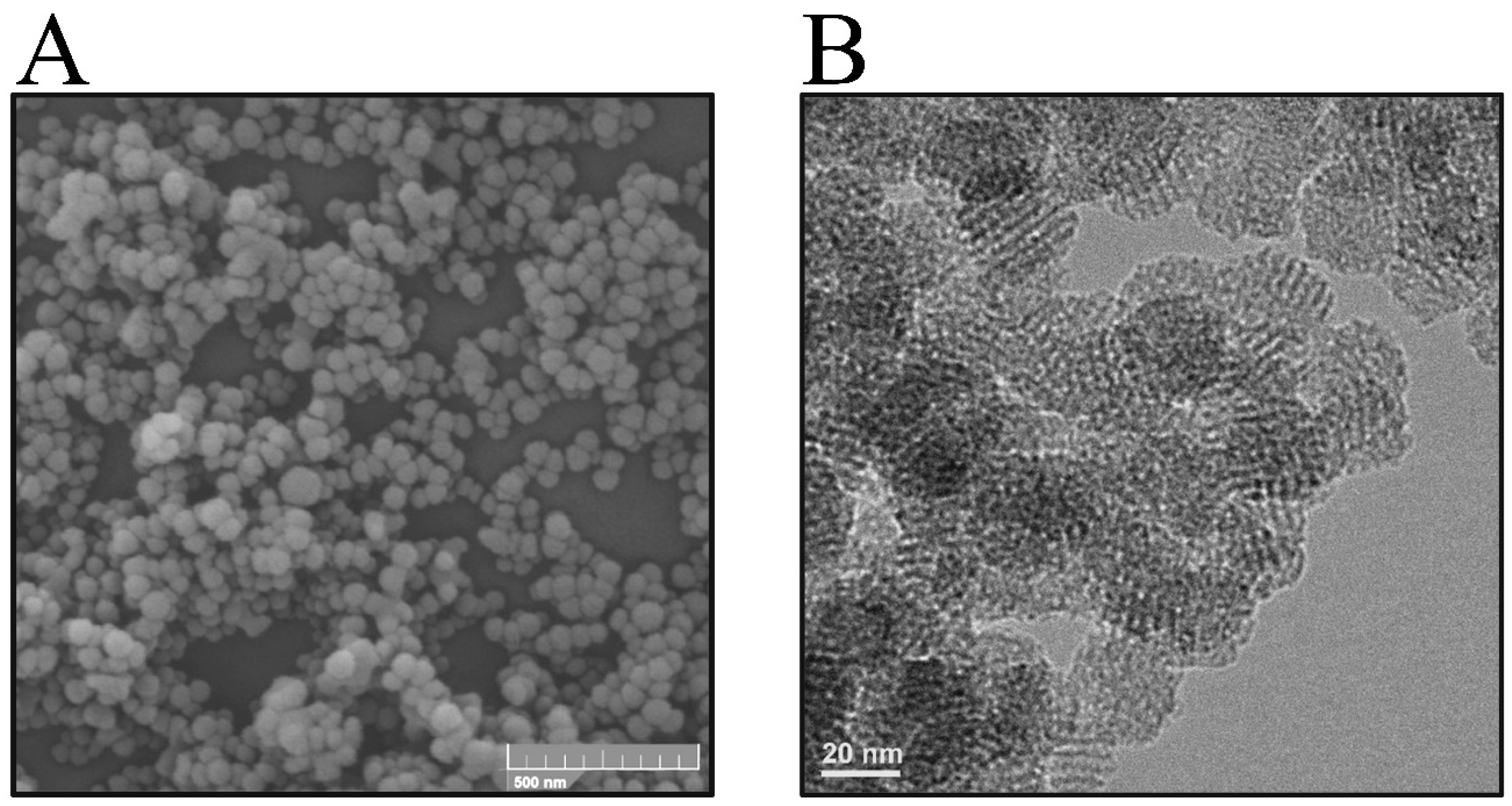
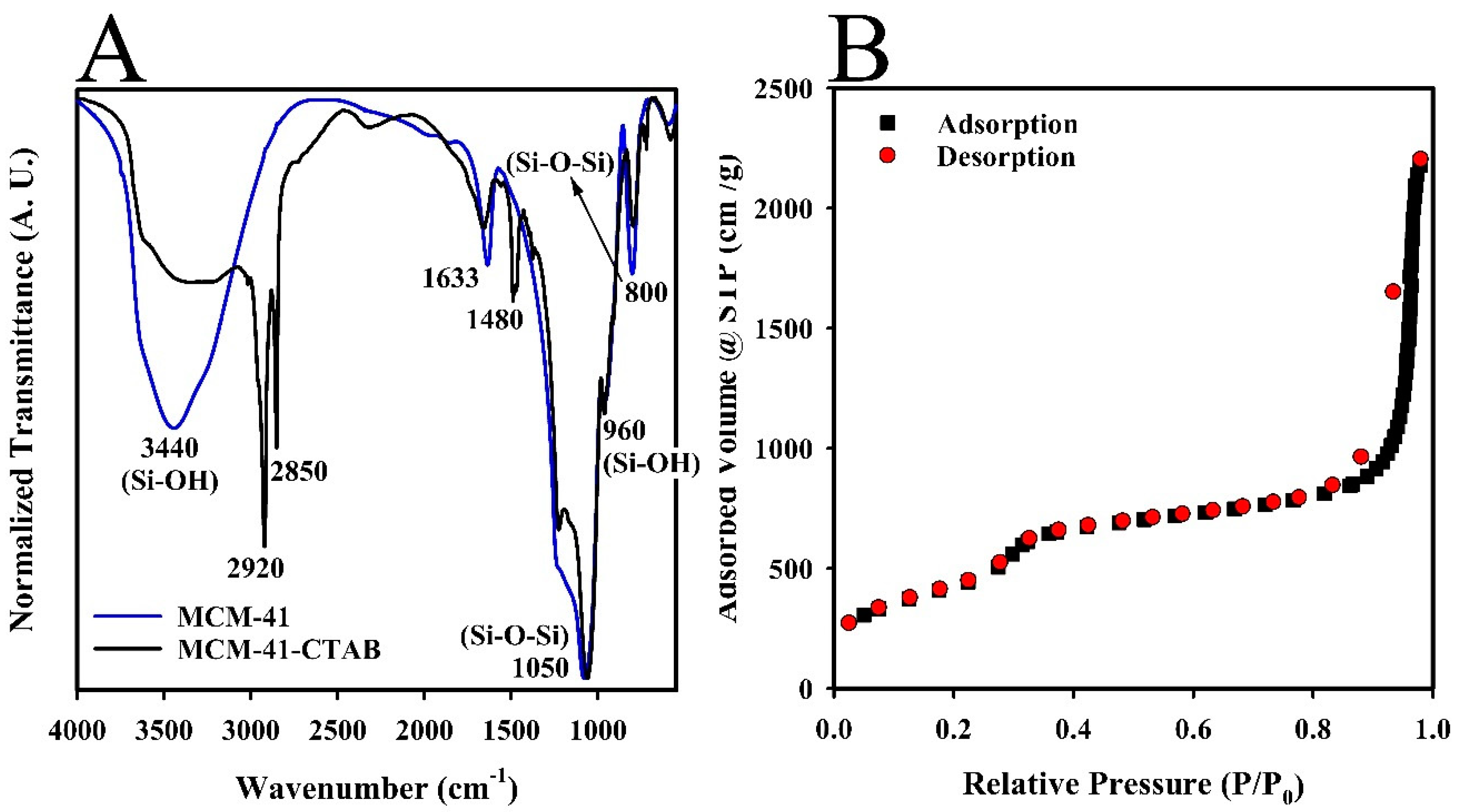
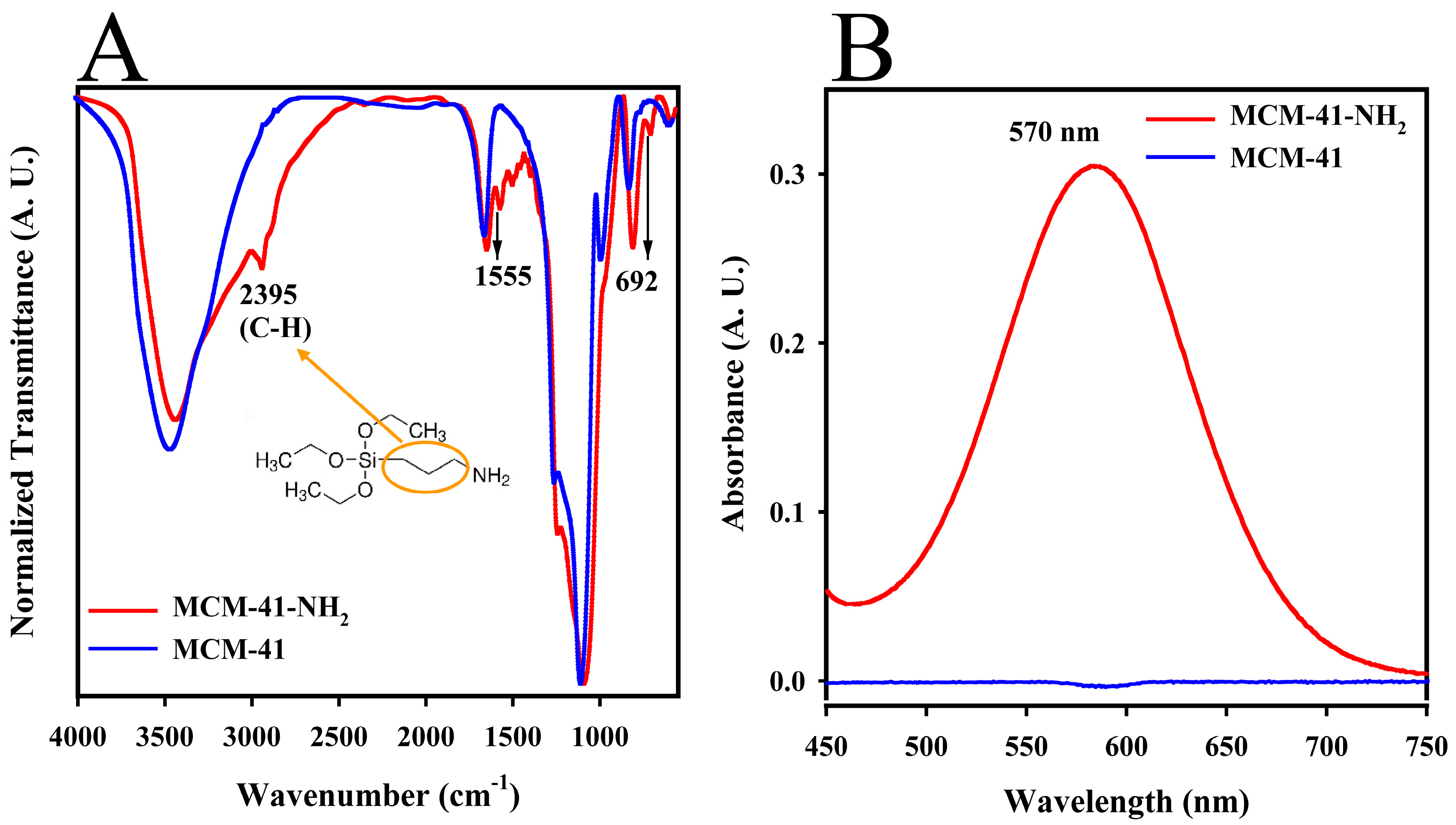


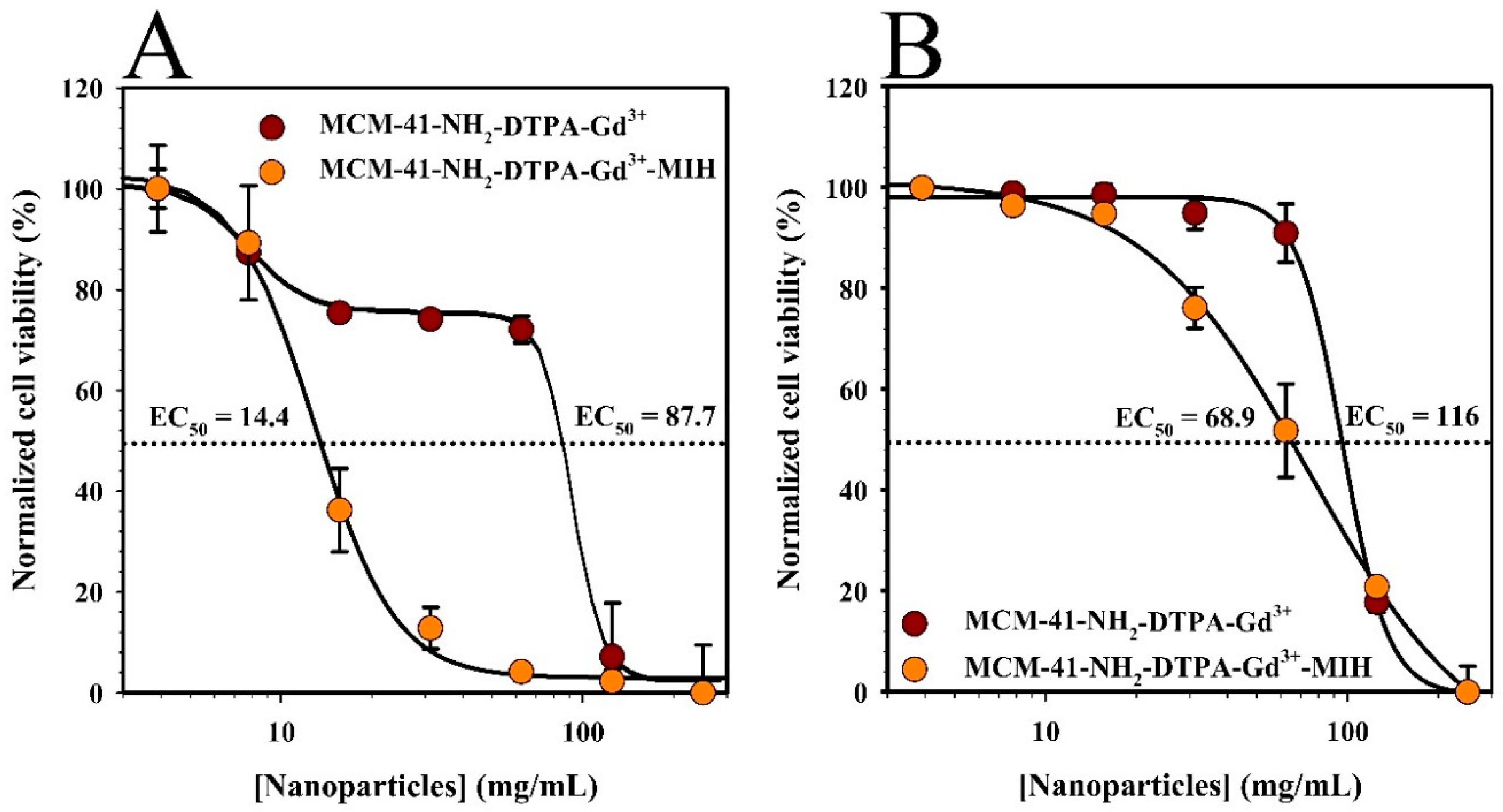
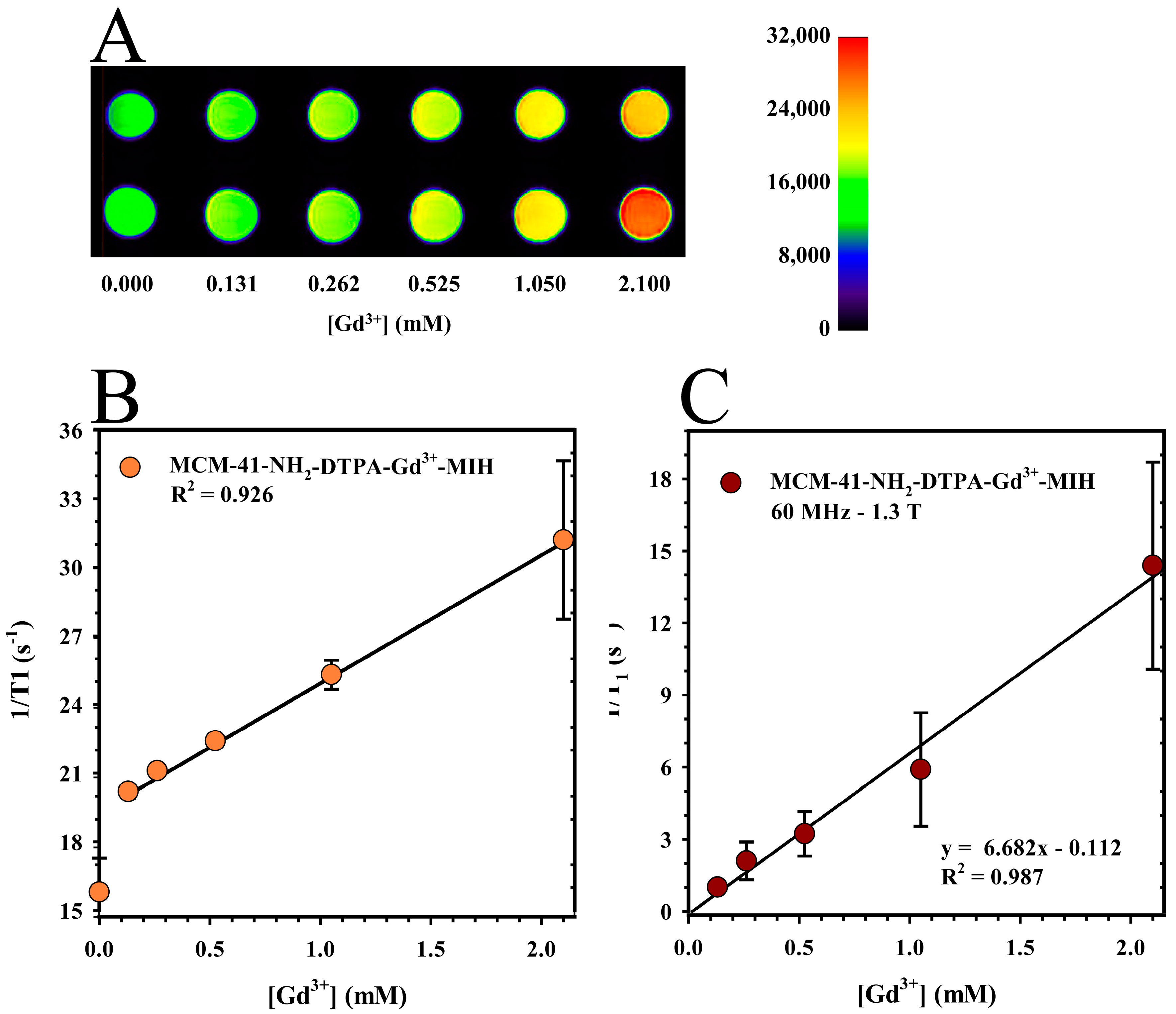
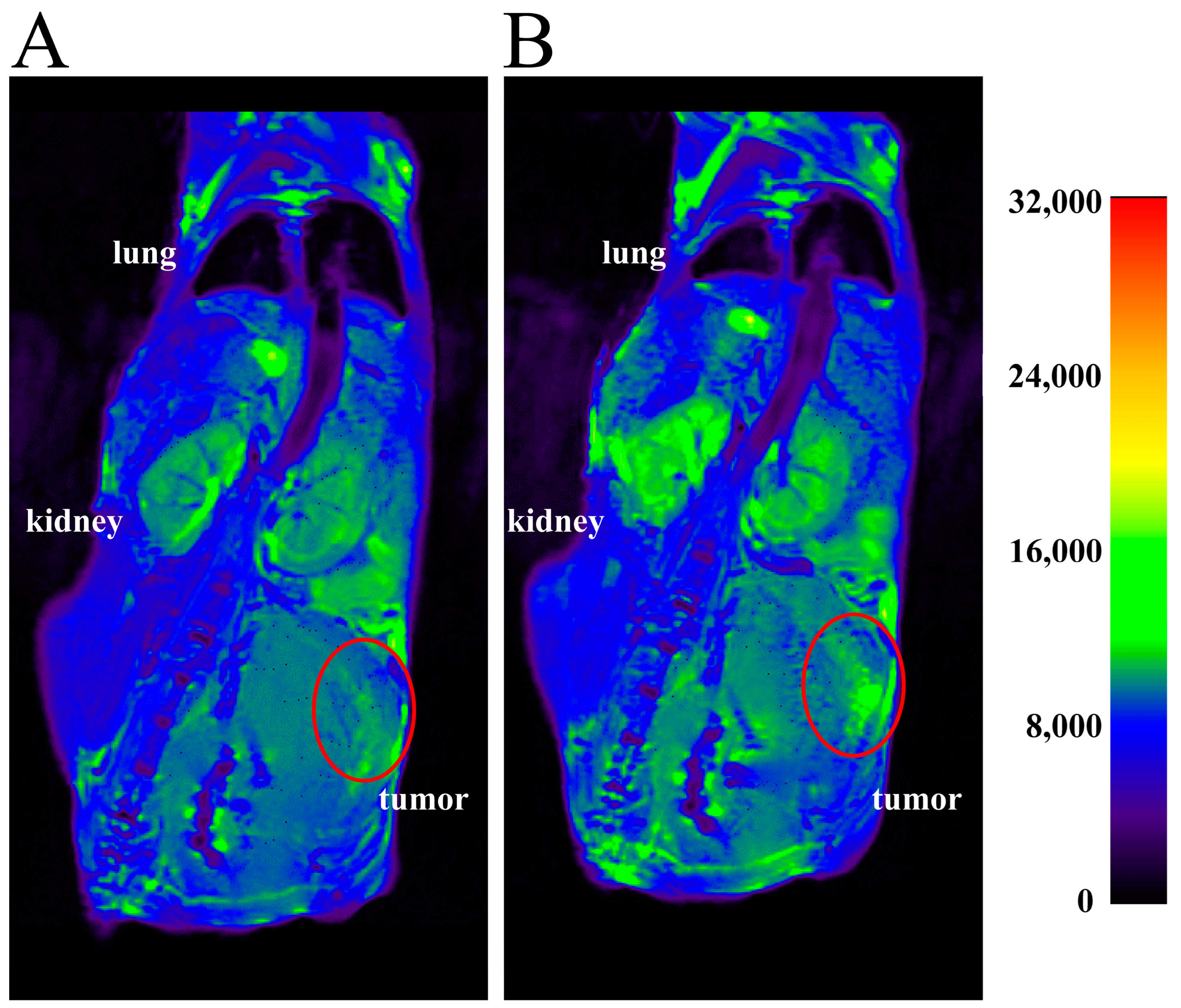
| Samples | Zeta Potential (mV) |
|---|---|
| MCM-41 | −22.5 ± 0.499 |
| MCM-41-NH2 | +12.9 ± 0.386 |
| MCM-41-NH2-DTPA | −16.1 ± 0.170 |
Disclaimer/Publisher’s Note: The statements, opinions and data contained in all publications are solely those of the individual author(s) and contributor(s) and not of MDPI and/or the editor(s). MDPI and/or the editor(s) disclaim responsibility for any injury to people or property resulting from any ideas, methods, instructions or products referred to in the content. |
© 2024 by the authors. Licensee MDPI, Basel, Switzerland. This article is an open access article distributed under the terms and conditions of the Creative Commons Attribution (CC BY) license (https://creativecommons.org/licenses/by/4.0/).
Share and Cite
Pires, I.C.B.; Shuchi, S.I.; Tostes, B.d.V.A.; Santos, D.K.D.d.N.; Burnett, W.L.; Leonce, B.C.; Harvey, O.R.; Coffer, J.L.; de Sousa Filho, I.A.; de Athayde-Filho, P.F.; et al. Theranostics Using MCM-41-Based Mesoporous Silica Nanoparticles: Integrating Magnetic Resonance Imaging and Novel Chemotherapy for Breast Cancer Treatment. Int. J. Mol. Sci. 2024, 25, 8097. https://doi.org/10.3390/ijms25158097
Pires ICB, Shuchi SI, Tostes BdVA, Santos DKDdN, Burnett WL, Leonce BC, Harvey OR, Coffer JL, de Sousa Filho IA, de Athayde-Filho PF, et al. Theranostics Using MCM-41-Based Mesoporous Silica Nanoparticles: Integrating Magnetic Resonance Imaging and Novel Chemotherapy for Breast Cancer Treatment. International Journal of Molecular Sciences. 2024; 25(15):8097. https://doi.org/10.3390/ijms25158097
Chicago/Turabian StylePires, Indira C. B., Samia I. Shuchi, Braulio de V. A. Tostes, Dayane K. D. do N. Santos, William L. Burnett, Burke C. Leonce, Omar R. Harvey, Jeffery L. Coffer, Idio Alves de Sousa Filho, Petrônio Filgueiras de Athayde-Filho, and et al. 2024. "Theranostics Using MCM-41-Based Mesoporous Silica Nanoparticles: Integrating Magnetic Resonance Imaging and Novel Chemotherapy for Breast Cancer Treatment" International Journal of Molecular Sciences 25, no. 15: 8097. https://doi.org/10.3390/ijms25158097






